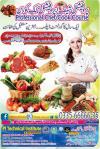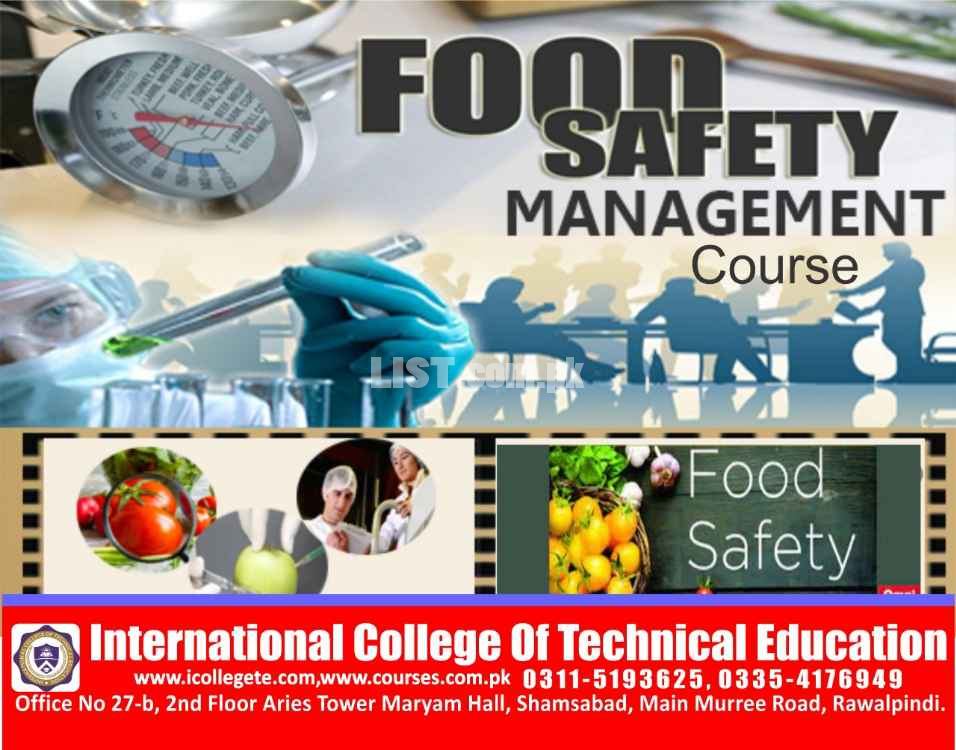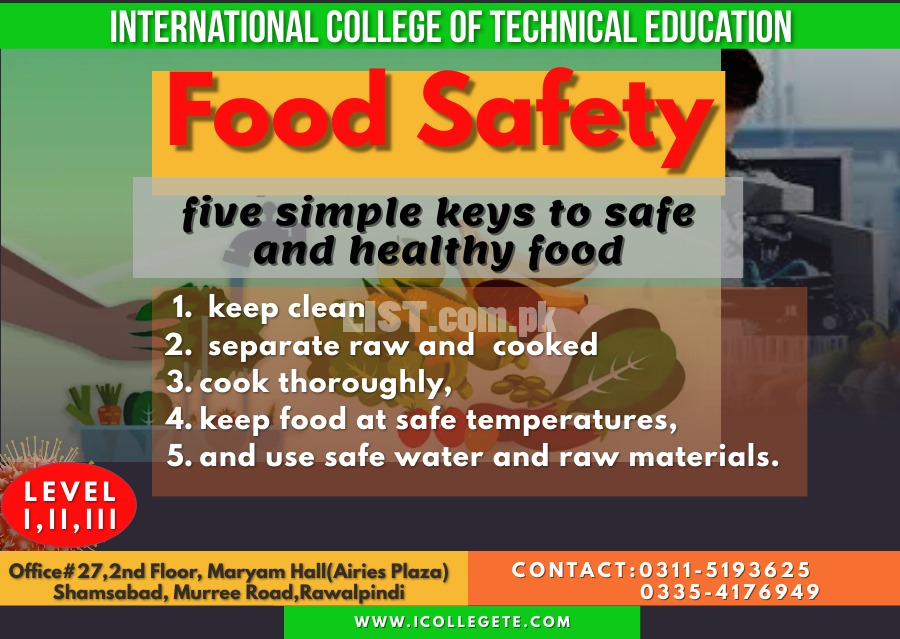International Food Safety Course In Rawalpindi Shekhupura
Brand
City
Region
International Food Safety course in Rawalpindi Shekhupura Services in Pakistan
Food safety refers to routines in the preparation, handling and storage of food meant to prevent foodborne illness and injury. From farm to factory to fork, food products may encounter any number of health hazards during their journey through the supply chain.foodborne diseases. Most of the time, the food handler is the one who intervenes as the vehicle of transmission of these diseases, so it is important that we take into account the great role we play in prevention.
The training of food handlers is mandatory and will allow you to obtain a certificate that will accredit you as a food handler, allowing you to work in the food industry. Although it is not mandatory, it is recommended to renew the certificate every 4 years, and to be updated according to the job. Then, the company itself should offer a specific training in its sector.
A food handler is anyone who, through their work activity, has direct contact with food during any of its phases until it reaches the final consumer. This includes: preparation, manufacture, processing, packaging, storage, transport, distribution, sale, supply and service.
This training course will enable you to perform food handling functions, and you should be responsible with this information, as the health of many consumers depends on you.According to the World Health Organization (WHO), health is a complete state of physical, mental and social well-being, and not just the absence of physical discomfort or illness.
So what is food hygiene? It is the group of measures needed to ensure food safety from farm to table, that is, from the moment they are obtained until they reach the final consumer.
Therefore, we define food-borne disease as any disease caused by consuming contaminated food.
It is important to maintain good food hygiene, as it will lead not only to a safer handling of food, but also to a good reputation for the company, increased customer satisfaction, and we will also avoid possible penalties from health authorities.FOOD CONTAMINATION. TYPES OF CONTAMINANTS AND HAZARDS.
What is food contamination? A contaminant or a food hazard is any foreign agent to the food that is capable of producing a negative effect on the health of the consumer.According to their origin the hazards are classified into:
Physics: bones, crystals, personal effects, etc.
Chemicals: toxic substances, cleaning products, etc.
Biological: living beings such as insects, rodents, birds, microorganisms, etc.
The main food contamination sources are:
The environment
Pests: living beings.
Utensils and premises: poor hygiene.
Garbage.
The food handler himself: due to lack of hygiene.
Other foods: this is very important, as we are talking about cross-Contamination (transfer of contaminants from one food to another). It can be given by mixing raw and cooked foods, or using the same utensils for different foods.Microorganisms act as a source of infection or food hazard. But what are microorganisms? They are also called germs or microbes and are living beings so small that they are invisible to the human eye.
Let’s list them according to the harm they can cause:
Beneficial: they are used for food processing.
Disruptive: they «warn» us of their presence, since they change the odour, colour, flavour and normal texture of the food.
Patogens: These are the most dangerous because at first glance they do not change the food properties. They are mainly responsible for food-borne diseases.
What do they need to live?
Nutrients: food.
Water.
Heat.
Acidity: as acidity increases, they become less contaminated by bacteria..
Oxygen: some bacteria live on oxygen (most of them), but others also grow without it.
Time: the more time passes, the more they multiply and the greater the risk.
The most frequent symptoms are general discomfort, vomiting, diarrhea and abdominal pain. But the most dangerous ones can cause serious injuries and even death.
What food is more dangerous or likely to become contaminated?
Those that pose a MAJOR RISK are:
Minced meat.
Fresh fish, shellfish and molluscs.
Raw products.
Fowl and Poultry.
Egg-based dishes (use of raw eggs is prohibited).
Pastry or bakery goods (especially those containing cream).
The maximum time a food retains all its organoleptic, nutritional and health properties is called shelf life. The most frequent and traditional conservation systems used are:
By cooling: refrigeration (Between 0º and 5ºC), freezing (less than -18ºC). The COLD CHAIN (or cool chain) must be maintained always. It consists of maintaining the cold (refrigeration or freezing) throughout the entire process through which the food passes: production, transport, reception, storage, sale to the consumer. If the correct temperature is not maintained during the whole process, the food will suffer IRREVERSIBLE consequences.
By heating: microorganisms are destroyed by heat. The most popular methods are: pasteurization, cooking, sterilization and ultra-pasteurization.
Removing part of the water from the food: drying, salting, curing, sugaring, smoking.
Others: pickling, use of preservatives.
ICTE
International College of Technical Education.
Head Office :
Office # 27, Second Floor, Maryam Shadi Hall Plaza
(Airies Plaza), Shamsabad, Murree Road,
Rawalpindi, Pakistan 46000.
Email : [email protected]
Contact : 051-8736681, 0311-5193625, 0092-335-4176949
International Food Safety course in Rawalpindi Shekhupura services are available in Pakistan at affordable price.
|
|
Education & Classes Services Related Ads

Sindh, Karachi

Islamabad, Islamabad

Islamabad, Islamabad

Islamabad, Islamabad

Islamabad, Islamabad
- Meet seller at a safe location
- Check the item before you buy
- Pay only after collecting item




Icte
Rawalpindi, Punjab, PakistanPhone No. 03115193625